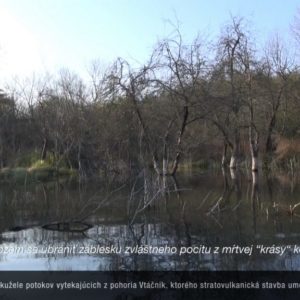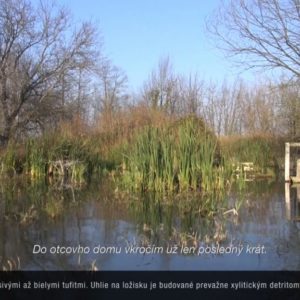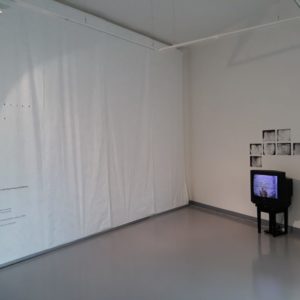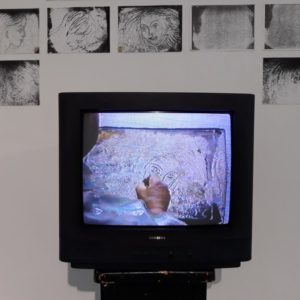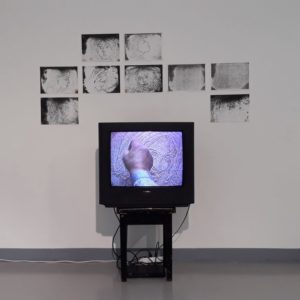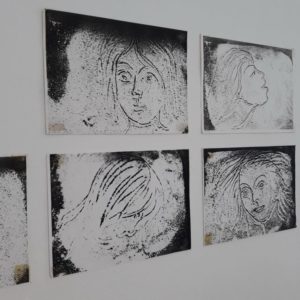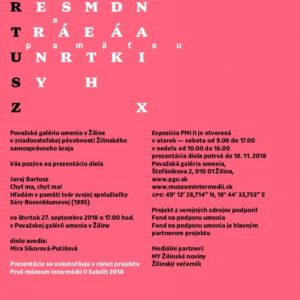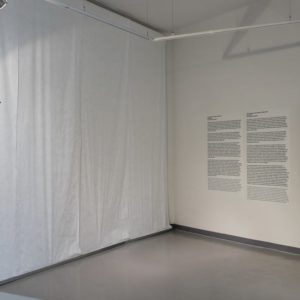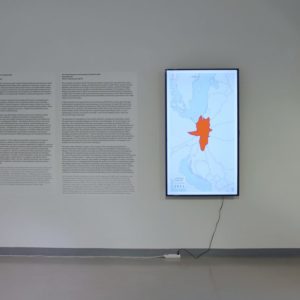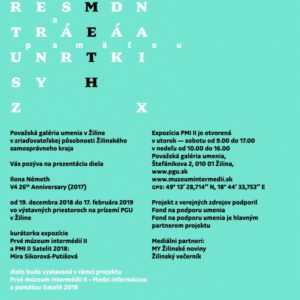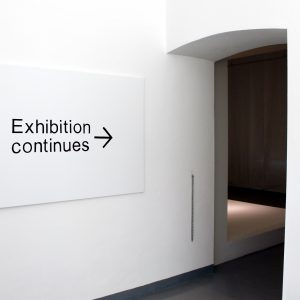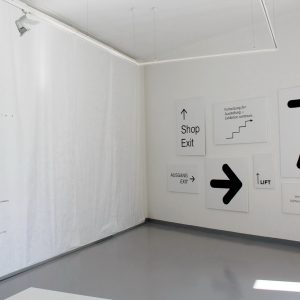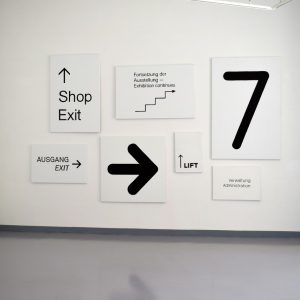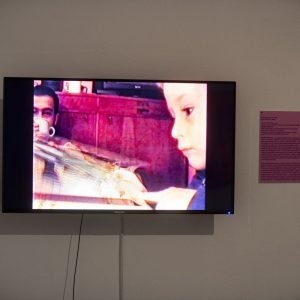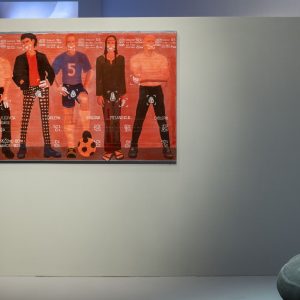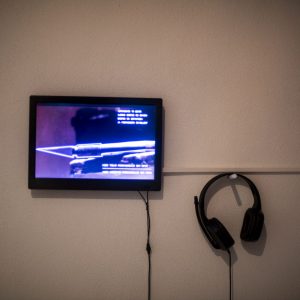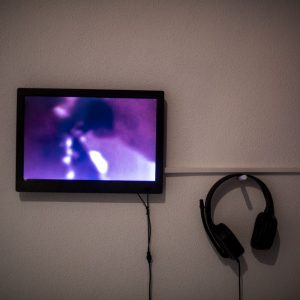Anton ─îierny – With Kind Permission of My Father, 2014 ÔÇô 2019
Anton ─îierny – With Kind Permission of My Father, 2014 ÔÇô 2019
During 1990’s, the intermedia nature of the work of Anton ─îierny (1963) was defined by creating objects and installations made with emphasis on their site-specific nature. Approximately since the turn of the millennium, this intermedia framework substantially ÔÇťdematerialisedÔÇŁ, and the ÔÇťsite-specificÔÇŁ was redefined as ÔÇťcontext-sensitiveÔÇŁ. The main medium of the artist’s expression became personally carried out private or public performances recorded on video and participative pieces. His interest in locations as spaces where one is anchored (in social, geographical, cultural, political context) and his interaction with the locations became more evident. The artist’s performances specifically made for video recording are mainly classified by exploring location that is selected based on specifics, but perceived by the artist as a complex unit. Concentrating on the memory of a specific place also became key, and it unfolds through the exploration of the space in often adventurous manners (like sailing an amateur-made vessel or balloon flight). This activity enables the artist to comment on the status of his subject, but most of all, to underline the difference between the so-called general (official) history of the given place, and its memory mediated by an individual’s point of view, whose subjective memory and his voice are almost always threatened by extinction in the passing of time.
The work With Kind Permission of My Father (2014 ÔÇô 2019) communicates the nuances of the artist’s personal (family) bond with the location of the village Lask├ír in the region of Horn├í Nitra. By concentrating on the wider contexts of this location ÔÇô historical, but also those contexts that create its current appearance, he defines his identification with this place. This performance for video originates in a lineage of works where the artist progressed from mapping of private space and exploring his own identity and its factors, to works that refer to wider contexts ÔÇô his own connection (as a native, national, state resident) to the places of genius loci with history connected to manifestations of nationalism, antisemitism, or negative impacts of totalitarian regimes.
With Kind Permission of My Father is a variation on formulating a relationship to a specific location: an emphasis on the hard to grasp factor of fellowship or showing the reality that an individual with personal ties to a location often only has minimal possibilities to influence the development and changing face of that place. This is represented by the models of individual and collective features of pieces that the artist carefully selects depending on the content and context.
ÔÇťThis video is a reflection of a submerged village Lask├ír near Nov├íky that became the victim of┬á mining industry in this region of Slovakia. First, an evacuation of inhabitants took place, then its demolition, an finally, it became one of many ground drops of this area flooded with water. I pass places that I used to visit (father’s birth place and my grandmother’s house) on a vessel that I constructed. I am looking for the house, the garden and a park, where I used to play. This piece isn’t only about a lost place or identity, but also about┬á strategic and economic interests of the state ÔÇô hidden politics of power leaving devastated environment behind.ÔÇŁ This is the citation of the artist’s statement about this work.
Exhibition is supported using public funding by Slovak Arts Council.
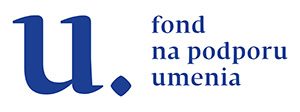
Peter R├│nai – autoReverse, 1997
Peter R├│nai – autoReverse, 1997
The long-term agenda of artist Peter R├│nai (1953) is the thematisation of the world of art through a strong subjectve lens ÔÇô aimed at the art’s condition and its perception at the time of maturing postmodern age ÔÇô especially the revision of ideas of the avant-garde resonating in the present times. The thematisation of the world of art offered by P. R├│nai is defined by an example of two interconnected aspects. One of them is his permanent self-ontextualisation ÔÇô defining his own position in art (as an art creator, author), but also making of an antithesis to art ÔÇô forms of communication/dialogue with art throughout its history (not only 20th century, but also earlier periods). The second aspect is his personal/existential ÔÇťself-presentationÔÇŁ through portrayal of his own face, mainly via the application of self-portrait photography. In the artist’s understanding, the function of this photography is naturally ambivalent: it underlines the cult of the artist, but also challenges it (through manipulation of the face), and therefore it is also iconoclastic.
The works KUNSinvHALLE (1972 ÔÇô 2014) and autoReverse (1997) can be perceived as an illustration of the mentioned interconnected aspects: KUNSTinHALLE actually demonstrates a system of the artist’s self-contextualisation, therefore it works as his entrance to the history of art. He uses tools of citation, interpretation, but also formulation of antitheses, but ÔÇô in the spirit of the avant-garde ÔÇô representing a portrayal of the fusion of life (private and artistic existence) and art. autoReverse is a portrait ÔÇô self-preservation and self-presentation, but also an example of self-reevaluation, or even self-irony by using metamorphosis/manipulation of his portrait or commenting on his own position as an artist.
In relation to the subject of the display First Museum of Intermedia: Memory and Information, pieces are presented as specific variations of the mentioned themes. autoReverse reflects the activity that is own to all of us ÔÇô creating traces of memory capturing the flow of our existence, such as photographs documenting individual stages of our lives. This video is a time-lapse version of the portrait of the artist ÔÇô it captures the transformations of his portrait from childhood to his likeness at the time of the completion of this work (1997). It takes form of a condensed personal photo album. He used the technique of morphing, enabling him to create smooth fade-over of one image to another in order to transform the photographs. At the time of making this work, the tools for morphing (PC technology and software) were quite inaccessible, and whatever is possible to achieve with any graphic software today, had to be made via a more complicated system ÔÇô individually, photo by photo. The technique of morphing is an important attribute of Peter R├│nai’s work ÔÇô treatment and manipulation of photography is essentially synchronous with thinking about one’s own identity and identity generally in several artists’ works and especially those working with the new media during the 1990’s.┬á Morphing, one of the strategies of creating post-photography (hybrid medium using elements of analogue and digital image and practices of media art) can define photography as an attribute/representative of identity freed from the traditional understanding of the flow of time, intervening in formatting and mechanisms of our memory. The video composed of 44 portraits overlapping one another was originally part of an installation with same title shown by the artist at the Videoanthology exhibition at Museum of Art ┼Żilina. This video piece was part of a typical medium of the second half of the 1990’s ÔÇô video installation created using the principles of the readymade. This was a supermarket shopping trolley filled with goods connected to a field bottle via cable. R├│nai modified this bottle for watching his self-portrait video on a small screen. The flow of time (present in his morphing portraits) or what we experience and lose, created a content opposition to what we gain and (do not need) paraphrased by the shopping in the trolley.
Exhibition is supported using public funding by Slovak Arts Council.

Juraj Bartusz – Catch me, Catch me! I am Searching for the Face of Classmate S├íra Rosenblum in My Memory, 1995
Juraj Bartusz – Catch me, Catch me! I am Searching for the Face of Classmate S├íra Rosenblum in My Memory, 1995
Installations Marchieren Marsch! (1993) and Catch me, Catch me! I am Searching for the Face of Classmate S├íra Rosenblum in My Memory (1995) were created by the artist during the 1990’s, when the expansion of the spatial media, mainly installation, characteristically prevailed. At that time, Juraj Bartusz (*1933) also produced several installations that represent the confirmation of the dominance of this medium, but also, in relation to their specific accidence and theme, they are unique models of installation. Their prototype form is anchored in Bartusz’s action art from 1970’s and 1980’s. Alongside the principle that defines the relationship between action and installation (installation is considered to be a form of concentrated action), the gesture of the artist is a very important identifier of these installations. Not as a form-making element of the work (means of its creation) present in other areas of his work but in the installations of Juraj Bartusz, gesture is rather a carrier of┬á meaning. It is an expression of the artist in form of an ironic or critical commentary, or it is a manifestation of resistance. In this notion, the artist’s gesture was also typical for action pieces in which he demasked and ironised nonsensical bureaucratic processes and mechanisms of the control of an individual’s privacy in a socialist society, or used them to express civil and human attitudes to social and later also ecological themes. Along with these, with their system of construction through selection of components and their provenance, the other installations from the first half of the 1990’s such as Back to Europe (1991) or Homeland (1992) declare an affinity to Arte Povera ÔÇô the artist constructs the installations from found materials, he uses natural resources (textile, leather, wood, stone, lining paper, wheat) and components that are tied more closely to the private life of an individual (suitcase, clothing). The installations of this artist also dispose of postmodern narration: they connect the articulation of important contemporary subjects of and individual’s and social existence with references to past experiences. Through this, they create a certain antidote (in meaning and composition) to the later installations produced by the generation of artists of 1990’s (R. Ond├ík, B. Ondrei─Źka, D. Lehock├í, P. Nov├íkov├í-Ondrei─Źkov├í) with a more ‘unmoved’ neo-conceptual code.
The artist created the installation Catch Me, Catch Me! I am Searching for the Face of Classmate S├íra Rosenblum in My Memory (1995) for the exhibition Dream of a Museum? (1995) at the Museum of Art in ┼Żilina. It was preceded by a private performance of the artist, where he would draw the face of his childhood classmate S├íra on a flour poured on a baking sheet from his memory, then shake the sheet in order to erase her face and start repeatedly drawing again, while the drawing process was recorded on a video that later became part of the video installation along with the baking sheets with drawings in flour. In the same year, he┬á presented a performance with the same name at Palmovka Synagogue in Prague. This work therefore connects an action art outcome with tangible artefact ÔÇô medium of sculpture. At the beginning of the 1990’s, the system of composing ÔÇô integration of performance recording/video with the body of an installation was typical for other artists as well (for example J. ┼Żelibsk├í, M.Nitz). Along with the installation Marschieren Marsch! (1993), these pieces are unique contributions to intermedia (installation) art of the 1990’s that reflect the problematics of historical and collective memory, but most of all, they draw attention to the threat of its failure and the consequences. Both works carry a strong personal thread of the artist’s experience of the Second World War. He created the installation Marschiern Marsch! from munition boxes that he found in the gallery loft. The morphology of this work refers to a specific experience: the front line crossed Kamen├şn in Southern Slovakia, the village where he comes from. The cumulation of boxes/suitcases, clothing and the presence of authentic post-explosion Katyuschas (found on the yard after the war) in the installation is an image of how devastatingly the war affected the country, but most of all lives of the many people that were forced to leave their homes. The video installation Catch me, Catch me! I am Searching for the Face of Classmate S├íra Rosenblum in My Memory portrays the growing impossibility/inability to recollect (and remember!) this worldwide trauma. It is a visual metaphor of forgetting portrayed in continual attempts to remember/draw the face of his Jewish classmate S├íra, a playful little girl that did not come to school one day, and the artist never saw her again. Both works correspond with the concept of the current display PM II dedicated to memory ÔÇô a phenomenon that strongly resonates in contemporary art. It also makes one of the paradoxes of current society present: being concerned with the past namely reflects fears of the future. This aspect of contemporary art was also prerecorded in many ways by installations of Juraj Bartusz created during the 1990’s.
Exhibition is supported using public funding by Slovak Arts Council.

(Sloven─Źina) Art you can eat / PRV├ë M├ÜZEUM INTERM├ëDI├Ź III / Ne┼żn├í sila
Ilona N├ęmeth – V4 26th ANNIVERSARY, 2017
Ilona N├ęmeth – V4 26th ANNIVERSARY, 2017
The computer animation V4 26th Anniversary shows section of a map where the states Poland, Czech Republic, Hungary and Slovakia are located. In 1991, these countries (Czech Republic and Slovakia as one state at the time) formed an alliance named V3 (Visegrad Three) which later became V4 after Czechoslovakia was divided. The foundation of this alliance was defined by an effort to cooperate in the process of the European integration. In 2004, after the states entered the European Union, the mission of this alliance defined itself as concentrating on the enforcement of stability and mutual cooperation in the wider region of Central Europe.
In this animation, the map of this section of Europe with the V4 countries goes through a deformation powered by the years passing on a chronoscope. It counts the years since the foundation of the alliance until the year 2026, when the V4 should celebrate the 35th anniversary of it’s existence. The deformation of the map, at the end of which the areas of the member states of V4 shrink into a small red spot resembling a drain, or more expressively, a rectum, also works reversibly ÔÇô back to the imaginary start, where we can see the map in real scale. Manipulation of the map encourages us to realize the gradual diversion from solidarity, mutual understanding and from tolerating otherness ÔÇô something that not only in Slovakia, but also in our surrounding countries becomes more and more apparent since as early as 1990. The animation also references the fact that although the Central European states went through the process of integration to Europe (during the 1990’s Slovakia intensively endorsed this ÔÇô mainly referring to the fact that it is located right in the middle of Europe), at the same time, gravitations towards nationalism and xenophobia grow stronger. As if the states of V4 created a fairly distorted reflection of the pact about friendship and cooperation that was actually established by Charles I. of Hungary, John of Bohemia and Casimir III. the Great in Visegrad.
The animation works with the problematics of historical memory in a similar manner ÔÇô it does not only point to the recent past, but also to the fact how memory and social construct may weaken or disappear altogether. It is also a merciless vision of the future: it metaphorically (through the motive of a rectum or drain) shows where the gradual elimination of solidarity, cooperation and respect in politics and society gets, and it is therefore a representation of how noble ideals disappear, become small or useless. In connection to the current events surrounding the Marrakesh Political Declaration on migration in Slovakia and the surrounding states, this animation showing the devaluation of ideas of cooperation and pro-European thought gains a more intensive current reference.
A symbolic pendant of this piece are works by the artist dedicated to the problematic of thinking in local contexts as opposed to the global reality ÔÇô an aspect also present in the V4 26th Anniversary. A contribution to the project Donaumonarchy (2006), the billboard Midpoint of Europe that shows nine centres of the continent with notes on when were they designated is the artist’s ironic commentary of the states’ attempts to make/own the geographical middle of our continent, which can be considered an act of local nationalism. An example is placing a stone as a symbolic centre of Europe in Kremnick├ę Bane in 1992, just before the founding of sovereign Slovakia, or proclamation of Nazis that based on measuring the centre in Dresden in 1900, the Third Reich is the heart of Europe with an entitlement to rule the others. Based on these motivations, the justness to dispose of the Midpoint of Europe is questionable, and contrary to the scientific methods which aren’t able to specify. Since 2009, Ilona N├ęmeth is in the process of making an open work with the same title, where she shows political and nationalist backgrounds of these attempts by commenting through creating her own signs designating the Midpoint of Europe, and placing them in her chosen locations (Rome, Brooklyn, Moscow). The line of reasoning that in the current map of the European Union, especially in the states of Central Europe, ideas of mutual cooperation and respect prevail, but at the same time, nationalist tendencies leading to gradual isolation of these states occur is a common denominator for the animation as well as for these works.
Ilona N├ęmeth (*1963) entered the art scene at the beginning of 1990’s with installations and site-specific works. The object Column (1995) is exhibited in the PMI II. The site-specific citation of a column is also a memory repository ÔÇô the cumulation of hair inside refers to the privacy and identity of unknown individuals. Starting roughly during the arrival of the new millennium, a strong engagement feature has been apparent in her work. She uses her pieces to comment on current affairs in the society ÔÇô they touch upon power, media manipulation, intolerance of minorities, and generally show a legible sociological dimension. The outreach of her work is strongly supported by its exhibition in the public space. Her current work is also defined by concentrating on contexts (social, historical) of the environment in which they are shown and the application of the artist’s individual experience from the given location.
Exhibition is supported using public funding by Slovak Arts Council

Stano Mas├ír ÔÇô Portraits of Institutions, 2017
Stano Mas├ír – Portraits of Institutions, 2017
(ART PLAN series – PDF)
The series of paintings is an allusion/evocation of navigation signs from prestigious art museums in Europe. The paintings stem from the authorÔÇÖs cycle of works dealing with the mechanisms related to presentation of visual art, where the world ÔÇťbehindÔÇŁ the art commonly seen at the exhibition becomes a┬áprimary part of this complex ÔÇô although it is seemingly invisible and insignificant.
Retaining the particular fonts and graphics, the author rewrites the selected signs (e.g. Fortsetzung der Ausstellung ÔÇô Exhibition continues from Hamburger Bahnhoff/Staatliche Museen in Berlin) and presents them as autonomous artworks. Furthermore, their placement in the actual access and communication areas of the Museum of Art in ┼Żilina creates a unique, and foremost artistic navigation for the visitors of the gallery.
Em├Âke Vargov├í – You’re Sitting on My Brain, 2001
Em├Âke Vargov├í (* 1965)
You’re Sitting on My Brain, 2001
mixed media, object, height 67 cm, ├ś 107 cm
from the collection of from the collection of the Museum of Art in ┼Żilina
acquired by purchase from the artist in 2010
The fact that the artist entered the scene around the mid 1990’s is only a basic identifier of her work, which ranks her among the women artists who shifted the hitherto latent, in our circumstances of art before 1989 also problematicly perceived, category of feminist art to the new updated coordinates. It was a period when the tendency of post-feminist art, which is considered one of the developmental stages of feminism – intensified in Slovak visual arts as well – one that rejects their radical language and emphasizes gender discourse in art. As in the case of her generational companions, E. Vargov├í’s work deals with this category in an analytical and, in her case, certainly also in an ironic way.
Em├Âke Vargov├í’s work is characterized by essential femininity. It is definitely coded in the selection of materials from which the author realized the objects and installations. These are soft, non-sculptural and transparent materials (especially wax, textiles, plastic, paper), but also its creation in the late 90.s and early zero years (including the work from PMI III display) appeared thinking about the functionality of things and the boundary between art and functionality – also because she realized several objects / furniture that carried a significant element of personification – e.g. a series of furniture “dressed” in clothes. The Medusa (2000) object, presented in the At Home Gallery in ┼áamor├şn, also dates from this period – it was an oversized “chandelier” sewn from a number of bras, “floating” in a blue-lit space – in the first sense as a reference to women in the synagogue, who could be present only in the so-called upper gallery. In that period, the artist’s self-referential approach became apparent, thinking about the (im) possibility of a universal individual, in which skills traditionally understood as female and male would coexist. By appropriating those belonging to the “stronger sex”, she created the Lagerfeld (2001) installation as part of the (in) time exhibition at PGU in ┼Żilina, where she inserted various small objects associated with d.i.y. (wires, sheet metal parts, pliers and other tools) into geometric composition into the plaster wall or the installation Fell! (2003), where she left a (provocatively) drilled drill in the wall after describing part of the clock face.
Object / stool You are Sitting on my Brain with its precise upholstery processing – again, there is a reflection on the functionality of art, but also a “feminine” effort to improve and aestheticize efficiency. The statement “you are sitting on my brain” can be deciphered as a fragment from an imaginary battle of the sexes – a clash of the worlds of a man and a woman with typical codes of thought, which is characterized by a degree of presumed mutual (mis) understanding. The object was created for the exhibition New Connection (2001) in NG in Prague, where the winners of the TONAL award (now the Oskar ─îepan Award) and its Czech equivalent of the Jind┼Öich Chalupeck├Ż Award exhibited.
The acquisition of this work was supported from public sources by the Slovak Arts Council.

The purchase of this work was financed with the contribution of the ┼Żilina self-governing region.
Gabika Binderov├í – East Side Story, 2003
Gabika Binderová (* 1975)
East Side Story, 2003
video, 9┬┤50┬┤┬┤, color, sound
screenplay and direction: Gabika Binderov├í, camera: Miroslav Li┼íka, Gabika Binderov├ífrom the collection of from the collection of the Museum of Art in ┼Żilina
acquired by purchase from the artist in 2017
At the beginning of the zero years, Gabika Binderov├í established herself as the author of installations, objects and videos that communicate the nuances of the microworld of an artist, but also woman, mother of twins – boys and wife. If we want to categorize her work in connection with gender art, which declares that the category of gender is a more complex unit, is not given biologically and is more social construction, it is necessary to look at Gabika Binder’s work through the optics of marital art, which according to the artist and curator Lenka Klodov├í (CZ) is characterized by the fact that it originates and is realized in an institutionalized union. However, it also indicates that the topics covered by the aspect of partnership, where gender is part of a wider range of contexts associated with marriage (psychological, social and sociological factor).
Gabika Binderov├í’s works from the beginning of the millennium were created as her own projects, but she also often collaborated with her husband Erik Binder: Mars and Venus Binder, Kunst-fa (as Kunst family), in which they left the viewer (or gallery visitor – especially the exhibition 2JA in Municipal Gallery in Rimavsk├í Sobota, 2001) to enter their marital microworld. They were realized mainly as installations consisting of realities from everyday life – so as to mediate the shades of the partnership, but also the physical or mental differences of its actors. In this respect, the joint (partnership-targeted) projects of Binder (now ex) spouses in our artistic environment are pioneering, and a decade later a similar art pattern, where the main code is partnership / marriage, was submitted by artists Pavl├şna Fichta ─îierna and Anton ─îierny in several joint videos from 2011 – 2012.
The video East side story is a self-portrait in the words of the artist. It reflects her family relationships, but its important element is also the sociological aspect – it shows the opposition of the periphery, where the artist comes from, and the center where she worked and lived as an artist. It is a compressed (visually compacted) road-movie capturing the journey of the Binder family from Bratislava to eastern Slovakia. In her words, it is also a metaphor for everyday life – just as the artist knows her day and its individual stops by heart, so the train from West to East and back has its own fixed and unchanging route. The plot of the film is intentionally cycled – at the end of their journey, the actors get off at the same place where they got on, as if they got nowhere, thus mixing time and space into one whole. The work was included in the collection for the exhibition Permanent Romanticism (GMB Bratislava, 2003), which presented romantic approaches in contemporary art, also at the exhibition Autopoesis (SNG Bratislava, 2006) devoted to the aspect of self-presentation, self-reflection, but also self-mythization of personality of an artist.
The acquisition of this work was supported from public sources by the Slovak Arts Council.

The purchase of this work was financed with the contribution of the ┼Żilina self-governing region.
Lucia Dovi─Ź├íkov├í – It is Scientifically Proven that …, 2003 and Stronger than Yesterday, 2005
Lucia Dovi─Ź├íkov├í (* 1981)
It is Scientifically Proven that We Select a Suitable Donor of Genetic Information According to Certain Criteria, 2003
oil on canvas, 160 x 100 cm
Stronger than Yesterday, 2005
video, PAL, sound, color, 1┬┤26┬┤┬┤
from the collection of from the collection of the Museum of Art in ┼Żilina
acquired by purchase from the artist in 2017
The artist introduced a significant code of self-reference into contemporary painting, it was an important part of her work, with which she entered the art scene just after the middle of the zero years and is still present today. Even now (fifteen years after finishing her studies), the dominant actor of her paintings is a woman in a wide range of typologies, we can really use the term “heroine” (and intentionally in quotation marks), as it covers her various forms: girl, wife, mother, pensioner, but also a mythological creature, a vampire or a Victorian model, and lately also a type that is (seemingly) submissive. However, we are still surprised by the artist’s talent to select a certain reality and point it out without embellishments. Some time ago, I wrote about Lucia Dovi─Ź├íkov├í’s paintings that they were subversive – and they never stopped being so. However, not so much the topics she has addressed and is addressing (we would normally describe them as intimate and partly still taboo or even perceived as irrelevant – as they are, for example, physicality altered by motherhood, the lunar cycle, fear and helplessness in caring for a newborn, breastfeeding peripetia, sexual fantasies, reluctance to clean the household, etc.) are the subversive element. It is her straightforwardness in which she approaches them, thus changing the perspective we look at (our own) female microworlds. And it is the changes in perspective that are the points mentioned.
Aquiring a pair of paintings and a video could seem like a risky step, as it is a juvenile – both works were created by the artist during her studies. However, both are – a protophase, a precursor of her self-reference. The video Stronger than Yesterday (in the year of its creation the artist completed an internship inatthe Studio of Spatial Communications with A. ─îierny at V┼áVU – several videos come from that time – perhaps less known, but at least from the point of view of the media important pendants of her paintings) is based on visualization and the soundtrack of James Cameron’s film Terminator. It is an expressively tuned and metaphorically grasped reaction of a woman who solves the hopelessness of her relationship with a man by radically giving up part of herself. A similar element of “scanning” reality through the eye of the cyborg – as an ironic-critical evaluation of the character traits and physical qualities of former partners and at the same time self-reflection of their “choices”, the artist used in the painting – It is Scientifically Proven that We Choose a Suitable Donor of Genetic Information According to Certain Criteria. Both works create a thematic diptych, the leitmotif of which (apart from the element of the artist’s nascent radical self-reference of that time) is also a form of appropriation of the visual motif from the action film.
The acquisition of this work was supported from public sources by the Slovak Arts Council.

The purchase of this work was financed with the contribution of the ┼Żilina self-governing region.



